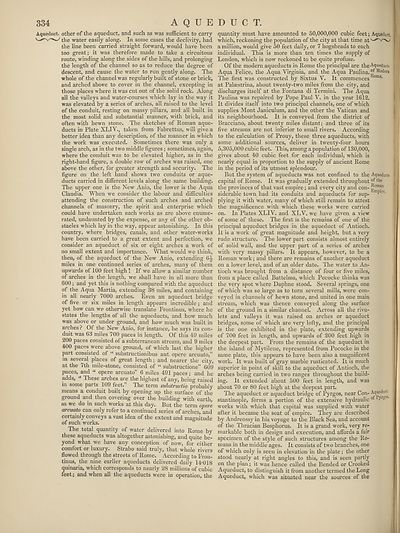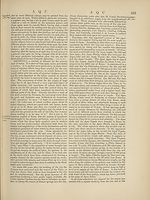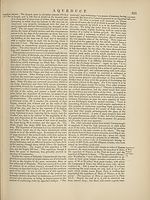Encyclopaedia Britannica > Volume 3, Anatomy-Astronomy
(342) Page 334
Download files
Complete book:
Individual page:
Thumbnail gallery: Grid view | List view

334 A Q U E
Aqueduct other of the aqueduct, and such as was sufficient to carry
the water easily along. In some cases the declivity, had
the line been carried straight forward, would have been
too great; it was therefore made to take a circuitous
route, winding along the sides of the hills, and prolonging
the length of the channel so as to reduce the degree of
descent, and cause the water to run gently along. The
whole of the channel was regularly built of stone or brick,
and arched above to cover in the channel, excepting in
those places where it was cut out of the solid rock. Along
all the valleys and water-courses which lay in the way it
was elevated by a series of arches, all raised to the level
of the conduit, resting on massy pillars, and all built in
the most solid and substantial manner, with brick, and
often with hewn stone. The sketches of Roman aque¬
ducts in Plate XLIV., taken from Fabrettus, will give a
better idea than any description, of the manner in which
the work was executed. Sometimes there was only a
single arch, as in the two middle figures; sometimes, again,
where the conduit was to be elevated higher, as in the
right-hand figure, a double row of arches was raised, one
above the other, for greater strength and security. The
figure on the left hand shows two conduits or aque¬
ducts carried in different levels along the same building.
The upper one is the New Anio, the lower is the Aqua
Claudia. When we consider the labour and difficulties
attending the construction of such arches and arched
channels of masonry, the spirit and enterprise which
could have undertaken such works as are above enume¬
rated, undaunted by the expense, or any of the other ob¬
stacles which lay in the way, appear astonishing. In this
country, where bridges, canals, and other water-works
have been carried to a great extent and perfection, we
consider an aqueduct of six or eight arches a work of
no small extent and importance. What would we think,
then, of the aqueduct of the New Anio, extending 6^
miles in one continued series of arches, many of them
upwards of 100 feet high ! If w'e allow a similar number
of arches in the length, we shall have in all more than
600; and yet this is nothing compared with the aqueduct
of the Aqua Martia, extending 38 miles, and containing
in all nearly 7000 arches. Even an aqueduct bridge
of five or six miles in length appears incredible ; and
yet how can we otherwise translate Frontinus, where he
states the lengths of all the aqueducts, and how much
was above or under ground, and how much was built in
arches ? Of the New Anio, for instance, he says its con¬
duit was 63 miles 700 paces in length. Of this 49 miles
200 paces consisted of a subterranean stream, and 9 miles
400 paces were above ground, of which last the higher
part consisted of “ substructionibus aut opere arcuato,”
in several places of great length; and nearer the city,
at the 7th mile-stone, consisted of “ substructione” 609
paces, and “ opere arcuato” 6 miles 491 paces; and he
adds, “ These arches are the highest of any, being raised
in some parts 109 feet.” The term substructio probably
means a conduit built by opening up the surface of the
ground and then covering over the building with earth,
as we do m such works at this day. But the term opcvc
arcuato can only refer to a continued series of arches, and
certainly conveys a vast idea of the extent and magnitude
of such works.
The total quantity of water delivered into Rome by
these aqueducts was altogether astonishing, and quite be¬
yond what we have any conception of now, for either
comfort or luxury. Strabo said truly, that whole rivers
flowed through the streets of Rome. According to Fron¬
tinus, the nine earlier aqueducts delivered daily 14'018
quinaria, which corresponds to nearly 28 millions of cubic
feet; and when all the aqueducts were in operation, the
DUCT.
quantity must have amounted to 50,000,000 cubic feet; Aqueduct,
which, reckoning the population of the city at that time at
a million, would give 50 feet daily, or 7 hogsheads to each
individual. This is more than ten times the supply of
London, which is now reckoned to be quite profuse.
Of the modern aqueducts in Rome the principal are the Aqueducts
Aqua Felice, the Aqua Virginia, and the Aqua Paulina. Moderii
The first was constructed by Sixtus V. It commences Kome•
at Palaestrina, about twenty-two miles from the city, and
discharges itself at the Fontana di Termini. The Aqua
Paulina was repaired by Pope Paul V. in the year 1612.
It divides itself into two principal channels, one of which
supplies Mont Janiculum, and the other the Vatican and
its neighbourhood. It is convej^ed from the district of
Bracciano, about twenty miles distant; and three of its
five streams are not inferior to small rivers. According
to the calculation of Prouy, these three aqueducts, with
some additional sources, deliver in twenty-four hours
5,305,000 cubic feet. This, among a population of 130,000,
gives about 40 cubic feet for each individual, which is
nearly equal in proportion to the supply of ancient Rome
in the period of its utmost splendour.
But the system of aqueducts was not confined to the Aqueducts
capital of Rome. It was gradually extended throughout of the
the provinces of that vast empire ; and every city and con- £l0mfn
siderable town had its conduits and aqueducts for sup- m^lre'
plying it with water, many of which still remain to attest
the magnificence with which these works were carried
on. In Plates XLIV. and XLV. we have given a view
of some of these. The first is the remains of one of the
principal aqueduct bridges in the aqueduct of Antioch.
It is a work of great magnitude and height, but a very
rude structure. The lower part consists almost entirely
of solid wall, and the upper part of a series of arches
with very massy pillars. It appears, however, to be a
Roman work; and there are remains of another aqueduct
on a lower level, and of an older date. The water to An¬
tioch was brought from a distance of four or five miles,
from a place called Battelma, which Pococke thinks was
the very spot where Daphne stood. Several springs, one
of which was so large as to turn several mills, were con¬
veyed in channels of hewn stone, and united in one main
stream, which was thence conveyed along the surface
of the ground in a similar channel. Across all the rivu¬
lets and valleys it was raised on arches or aqueduct
bridges, some of which are very lofty, and the principal
is the one exhibited in the plate, extending upwards
of 700 feet in length, and upwards of 200 feet high in
the deepest part. From the remains of the aqueduct in
the island of Mytilene, represented from Pococke in the
same plate, this appears to have been also a magnificent
work. It was built of gray marble rusticated. It is much
superior in point of skill to the aqueduct of Antioch, the
arches being carried in two ranges throughout the build¬
ing. It extended about 500 feet in length, and was
about 70 or 80 feet high at the deepest part.
The aqueduct or aqueduct bridge of Pyrgos, near Con- Aqueduct
stantinople, forms a portion of the extensive hydraulicof
works with which that capital was supplied with water
after it became the seat of empire. They are described
by Andreossy in his voyage to the Black Sea, and account
of the Thracian Bosphorus. It is a grand work, very re¬
markable both in design and execution, and affords a fair
specimen of the style of such structures among the Ro¬
mans in the middle ages. It consists of two branches, one
of which only is seen in elevation in the plate; the other
stood nearly at right angles to this, and is seen partly
on the plan; it was hence called the Bended or Crooked
Aqueduct, to distinguish it from another termed the Long
Aqueduct, which was situated near the sources of the
Aqueduct other of the aqueduct, and such as was sufficient to carry
the water easily along. In some cases the declivity, had
the line been carried straight forward, would have been
too great; it was therefore made to take a circuitous
route, winding along the sides of the hills, and prolonging
the length of the channel so as to reduce the degree of
descent, and cause the water to run gently along. The
whole of the channel was regularly built of stone or brick,
and arched above to cover in the channel, excepting in
those places where it was cut out of the solid rock. Along
all the valleys and water-courses which lay in the way it
was elevated by a series of arches, all raised to the level
of the conduit, resting on massy pillars, and all built in
the most solid and substantial manner, with brick, and
often with hewn stone. The sketches of Roman aque¬
ducts in Plate XLIV., taken from Fabrettus, will give a
better idea than any description, of the manner in which
the work was executed. Sometimes there was only a
single arch, as in the two middle figures; sometimes, again,
where the conduit was to be elevated higher, as in the
right-hand figure, a double row of arches was raised, one
above the other, for greater strength and security. The
figure on the left hand shows two conduits or aque¬
ducts carried in different levels along the same building.
The upper one is the New Anio, the lower is the Aqua
Claudia. When we consider the labour and difficulties
attending the construction of such arches and arched
channels of masonry, the spirit and enterprise which
could have undertaken such works as are above enume¬
rated, undaunted by the expense, or any of the other ob¬
stacles which lay in the way, appear astonishing. In this
country, where bridges, canals, and other water-works
have been carried to a great extent and perfection, we
consider an aqueduct of six or eight arches a work of
no small extent and importance. What would we think,
then, of the aqueduct of the New Anio, extending 6^
miles in one continued series of arches, many of them
upwards of 100 feet high ! If w'e allow a similar number
of arches in the length, we shall have in all more than
600; and yet this is nothing compared with the aqueduct
of the Aqua Martia, extending 38 miles, and containing
in all nearly 7000 arches. Even an aqueduct bridge
of five or six miles in length appears incredible ; and
yet how can we otherwise translate Frontinus, where he
states the lengths of all the aqueducts, and how much
was above or under ground, and how much was built in
arches ? Of the New Anio, for instance, he says its con¬
duit was 63 miles 700 paces in length. Of this 49 miles
200 paces consisted of a subterranean stream, and 9 miles
400 paces were above ground, of which last the higher
part consisted of “ substructionibus aut opere arcuato,”
in several places of great length; and nearer the city,
at the 7th mile-stone, consisted of “ substructione” 609
paces, and “ opere arcuato” 6 miles 491 paces; and he
adds, “ These arches are the highest of any, being raised
in some parts 109 feet.” The term substructio probably
means a conduit built by opening up the surface of the
ground and then covering over the building with earth,
as we do m such works at this day. But the term opcvc
arcuato can only refer to a continued series of arches, and
certainly conveys a vast idea of the extent and magnitude
of such works.
The total quantity of water delivered into Rome by
these aqueducts was altogether astonishing, and quite be¬
yond what we have any conception of now, for either
comfort or luxury. Strabo said truly, that whole rivers
flowed through the streets of Rome. According to Fron¬
tinus, the nine earlier aqueducts delivered daily 14'018
quinaria, which corresponds to nearly 28 millions of cubic
feet; and when all the aqueducts were in operation, the
DUCT.
quantity must have amounted to 50,000,000 cubic feet; Aqueduct,
which, reckoning the population of the city at that time at
a million, would give 50 feet daily, or 7 hogsheads to each
individual. This is more than ten times the supply of
London, which is now reckoned to be quite profuse.
Of the modern aqueducts in Rome the principal are the Aqueducts
Aqua Felice, the Aqua Virginia, and the Aqua Paulina. Moderii
The first was constructed by Sixtus V. It commences Kome•
at Palaestrina, about twenty-two miles from the city, and
discharges itself at the Fontana di Termini. The Aqua
Paulina was repaired by Pope Paul V. in the year 1612.
It divides itself into two principal channels, one of which
supplies Mont Janiculum, and the other the Vatican and
its neighbourhood. It is convej^ed from the district of
Bracciano, about twenty miles distant; and three of its
five streams are not inferior to small rivers. According
to the calculation of Prouy, these three aqueducts, with
some additional sources, deliver in twenty-four hours
5,305,000 cubic feet. This, among a population of 130,000,
gives about 40 cubic feet for each individual, which is
nearly equal in proportion to the supply of ancient Rome
in the period of its utmost splendour.
But the system of aqueducts was not confined to the Aqueducts
capital of Rome. It was gradually extended throughout of the
the provinces of that vast empire ; and every city and con- £l0mfn
siderable town had its conduits and aqueducts for sup- m^lre'
plying it with water, many of which still remain to attest
the magnificence with which these works were carried
on. In Plates XLIV. and XLV. we have given a view
of some of these. The first is the remains of one of the
principal aqueduct bridges in the aqueduct of Antioch.
It is a work of great magnitude and height, but a very
rude structure. The lower part consists almost entirely
of solid wall, and the upper part of a series of arches
with very massy pillars. It appears, however, to be a
Roman work; and there are remains of another aqueduct
on a lower level, and of an older date. The water to An¬
tioch was brought from a distance of four or five miles,
from a place called Battelma, which Pococke thinks was
the very spot where Daphne stood. Several springs, one
of which was so large as to turn several mills, were con¬
veyed in channels of hewn stone, and united in one main
stream, which was thence conveyed along the surface
of the ground in a similar channel. Across all the rivu¬
lets and valleys it was raised on arches or aqueduct
bridges, some of which are very lofty, and the principal
is the one exhibited in the plate, extending upwards
of 700 feet in length, and upwards of 200 feet high in
the deepest part. From the remains of the aqueduct in
the island of Mytilene, represented from Pococke in the
same plate, this appears to have been also a magnificent
work. It was built of gray marble rusticated. It is much
superior in point of skill to the aqueduct of Antioch, the
arches being carried in two ranges throughout the build¬
ing. It extended about 500 feet in length, and was
about 70 or 80 feet high at the deepest part.
The aqueduct or aqueduct bridge of Pyrgos, near Con- Aqueduct
stantinople, forms a portion of the extensive hydraulicof
works with which that capital was supplied with water
after it became the seat of empire. They are described
by Andreossy in his voyage to the Black Sea, and account
of the Thracian Bosphorus. It is a grand work, very re¬
markable both in design and execution, and affords a fair
specimen of the style of such structures among the Ro¬
mans in the middle ages. It consists of two branches, one
of which only is seen in elevation in the plate; the other
stood nearly at right angles to this, and is seen partly
on the plan; it was hence called the Bended or Crooked
Aqueduct, to distinguish it from another termed the Long
Aqueduct, which was situated near the sources of the
Set display mode to:
![]() Universal Viewer |
Universal Viewer | ![]() Mirador |
Large image | Transcription
Mirador |
Large image | Transcription
Images and transcriptions on this page, including medium image downloads, may be used under the Creative Commons Attribution 4.0 International Licence unless otherwise stated. ![]()
| Encyclopaedia Britannica > Encyclopaedia Britannica > Volume 3, Anatomy-Astronomy > (342) Page 334 |
|---|
| Permanent URL | https://digital.nls.uk/193761794 |
|---|
| Attribution and copyright: |
|
|---|---|
| Shelfmark | EB.16 |
|---|---|
| Description | Ten editions of 'Encyclopaedia Britannica', issued from 1768-1903, in 231 volumes. Originally issued in 100 weekly parts (3 volumes) between 1768 and 1771 by publishers: Colin Macfarquhar and Andrew Bell (Edinburgh); editor: William Smellie: engraver: Andrew Bell. Expanded editions in the 19th century featured more volumes and contributions from leading experts in their fields. Managed and published in Edinburgh up to the 9th edition (25 volumes, from 1875-1889); the 10th edition (1902-1903) re-issued the 9th edition, with 11 supplementary volumes. |
|---|---|
| Additional NLS resources: |
|

